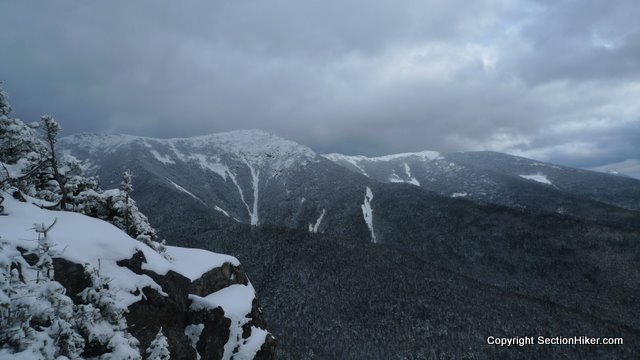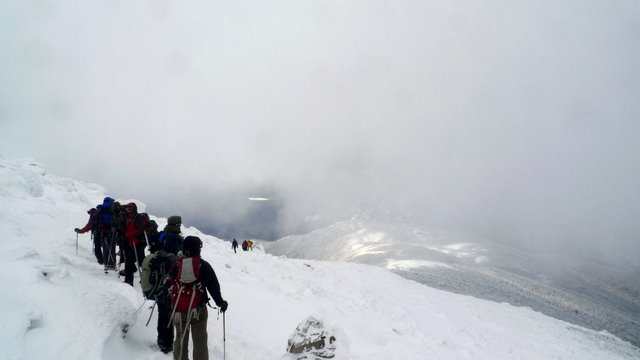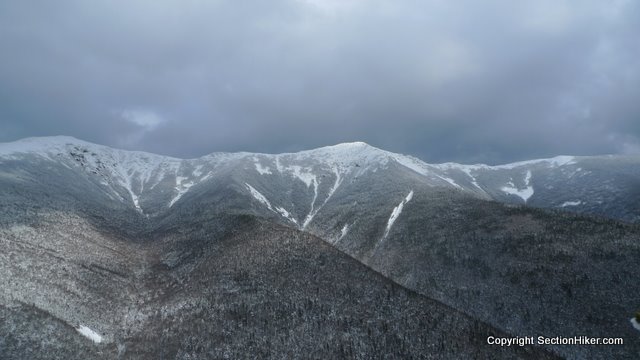
This was the big one: Franconia Ridge, including a pair of five thousand footers, Mount Lincoln and Mount Lafayette. All of the White Mountain hikes and training I’ve been doing this winter have been in preparation for this traverse, one of the most picturesque and strenuous, above-treeline hikes in the White Mountains, with a total elevation gain of 4,200 feet.
We had pretty good conditions on Saturday, all things considered, with temperatures in the 20’s (F) and winds from the southwest at 20-30 mph. Still we ended up hiking the ridge in cloud, which was disconcerting since there are steep drop-offs along the western cliffs.
We took the normal route up to the ridge, climbing the Falling Waters Trail from the base of Franconia Notch and popping above treeline at Little Haystack Mountain (4,780 feet.) The trail up was reasonably well packed out, so we left our snowshoes in the car and bare booted it for about a mile before switching to traction. Although steep, this is a well graded trail that passes by many frozen waterfalls as it climbs 1000 meters to treeline, over a distance of 3.7 miles.

Just below treeline, we changed into above treeline winter garb including heavier gloves, balaclavas, face masks, and ski goggles. Most of us put on a thermal mid layer and regular hard shells, but it was still warm enough that people could expose their hands for short periods of time without gloves.
The trail up top was a combination of ice, wind slab, and some smaller snowdrifts. We proceeded to hike down the ridge which is only 1.6 miles from Little Haystack to Lafayette. It all went by eerily fast and I really couldn’t discern any landmarks, including the summit of Mount Lincoln, until we came to the summit sign on Lafayette.
For safety, we kept the group of 12 (9 hikers and 3 AMC leaders) close together because visibility was poor, but it took a certain amount of vigilance to keep the front and back halves of the group in sight of one another. It’s definitely a challenge for leaders to instill strong group cohesion (looking out for one another) in a group of individuals, many who’ve just met for the first time, even more so in such an alien environment.
Don’t get me wrong: we had an experienced group, but for above treeline winter hikes like this, it seems that having a slightly higher participant-to-leader ratio than normal made it easier for us to keep the group together and deal with contingencies as they arose (something for me to file away for when I become a winter leader.)

We took a short food break as we neared Mt Lafayette and I moved to the front of the group to lead the way to the summit. I knew the bearing and I could see the slope gradient so I knew we were headed in the right direction. Still I was cautious because we were under heavy cloud and it would have been very easy to walk right past the summit sign and continue north along the ridge.
One of our participants had a GPS and was insistent that he knew how to get to the summit. I let him take point and he brought us right to the sign! That was an eye opener for me. I’m not a big fan of GPS devices because I’m wary of them being mis-calibrated or experiencing battery failure, but it was really helpful to have one in these conditions, at least as another navigation tool.
While I’m sure we could have found the summit sign eventually, I knew we had a few tired hikers in our group. You really need find the summit sign on Lafayette in order to find the western cairns down to Greenleaf Hut. While it’s conceivable that you could find the cairns another way, you can easily overshoot them in a whiteout, and descend into the next valley below the northern shoulder of Lafayette.

After we all got to the sign, Stephen led our descent down Lafayette and down to the relative safety of Greenleaf Hut. Visibility was about 20 yards, tops, and we had to keep the group tightly packed so that people could keep sight of the person in front of them. I counted the group as they filed past and took up sweep at the end of the line.

Just below the summit, we encountered an area of hard wind slab where the easterly winds hit Lafayette and compress the snow into a hard slippery crust. Two members of our party who were wearing microspikes, slipped and slid down the wind slab. It was a little scary because they didn’t have axes to self-arrest and I wasn’t sure how far the slab extended down-slope. The first one to fall was slow getting up, just as the second hiker fell and slid into him. I crunched down in my crampons and helped pick up some dropped gear; they were both ok, but it highlighted the limitations of microspikes on a peak like this.

As we continued our descent, the clouds over Layfayette and Franconia Notch began to break up and we could see limited views of Greenleaf Hut and Cannon Mountain, beyond. Within an hour, the whole ridge cleared off. By that time, we’d made it down to the hut, which is closed during winter, but still makes a good wind break, and enjoyed a good rest in the sunshine.

From the hut, we had a fairly routine, but steep walk down the Bridle Path back to our cars at the trail head. This was good hike and I appreciate being asked to co-lead it. Despite the fog, the temperature and wind speed on the ridge were quite comfortable and it was nice to be able to descend Lafayette and the Bridle Path with such grand views. Franconia Ridge is definitely one of the more challenging hikes in the Whites and even more so in winter.
 SectionHiker.com Backpacking Gear Reviews and FAQs
SectionHiker.com Backpacking Gear Reviews and FAQs
Another great post! One question, though: How do you make the maps you include with your trip reports? I have the Trimble Backpacker app on my Android, but I really like the look of the NatGeo maps you use.
I use a desktop program called TOPO! 4 with NG’s New England Map CD.I bought it at REI last year.
They’ve actually since updated it – here’s the new version.
https://www.rei.com/product/849099/national-geographic-ultimate-outdoor-map-kit
I mainly use it for route planning and blogging.
Thanks Philip. How do you get the tracks onto the map? Do you use some kind of GPS device?
When you are trip planning, do you draw a track with a mouse or something?
Thanks for all the work you do on this site, BTW. It is my favorite- very inspiring and informative.
There’s a route tool in TOPO for drawing tracks with your mouse. Then I save the whole thing to Jpg and paste it into my blog posts as a photo. I don’t bother saving the routes to GPS – but that may change for winter – I mainly use this tool for planning bushwhacks and very long multi-day hikes. The rest of the time and when I’m hiking, I just carry a map, compass, and spreadsheet.
Part of my 5:30am morning routine (!) is checking out SH on my android phone. It sure was nice to see that SH now has a cool mobile theme installed. And, of course, reading about the ridge walk that is my favorite (and first) above tree line made it all the better. Thanks again Earlylite!
Steve – Bondcliff is calling you. Come visit sometime.
Very impressive hike; by now you must be in super shape.
Slowly getting there. I can climb elevation though. I’d say my mental conditioning is finally a little further along then my physical conditioning. I no longer say “I think I can” at the base of a peak. it’s “I will”. That may sound a bit crazy, but it’s something that’s a very real part of my experience in winter.
Nice write-up.
Having a GPS and knowing how to navigate with it are two different things. I plan my route in a manner similar to yours and then put key way-points in my GPS. The plan is to navigate using visual cues linked to the map and compass, but sometimes that isn’t always possible and I’ll use the GPS. I’ve been on a few hikes where if we followed the lead of the person claiming to navigate with a GPS we would still be in the woods. I’ve never had it fail (have a Garmin 60csx and not some app on my phone) and make sure I have spare batteries. I always set it to record my track – useful in navigation so not go in circles and interesting to see where you went when you get back. I know how to use a map and a compass – unfortunately not everyone BRINGS a map and compass, let alone know how to use it.
Some consider it “cheating” because it’s not the way our forefathers climbed, I saw use what you can. Our forefathers rode horses to the trailhead (not a hybrid Prius), carried sacks made of heavy canvas, if they had a map it was scratched out on a piece of paper (not high-tech computer and GPS generated tyvek), there was no fleece or gore-tex, there snowshoes were made of wood and animal skins (from animals they likely killed), and their crampons were screws put into the bottom of their “three season” boots. When this describes the person complaining then I’ll listen.
I’ve written in another of your posts about my slide and fall on the climb up to Lafayette – similar conditions except brutal wind. We turned back about a 1/4 mile from the summit. Whenever above treeline travel I require my groups to have full mountaineering crampons – chains that attach to your feet with rubber bands can be brought, but only as back-up. Some complain and choose other groups to hike with, that’s fine with me – no hard feelings. Anyway, I didn’t have MY crampons. Had taken them out at the trailhead to put some food in, got distracted, and then never put them back. Didn’t realize until I needed them (I now keep them on the outside of my pack so I can visually check them).
Coming down there was some snow drifts we had to cross and the thickness of the snow was more than the length of the spikes I was wearing so they never gripped the ice and down I went. Slid about 50 yards and steered myself into a rock to stop – perfect physics, I transferred all of my energy to the rock, the rock popped out and rolled down the hill while I cake to stop in the hole where the rock was.
Good job! For all intents and purposes the group was “mountaineering”. At the very least, everyone should have crampons, whether aluminum or steel, especially traveling above treeline. The two who slid are lucky they did not become a stat. Another reason microspikes should be confined to icy sidewalks and trail use only. They were clearly pushed past their intended design.
Sounds like a fun outing. I think the weather will be a little different on your trip to Austin this week.
Like Michael, I use a GPS as my primary navigation tool but always carry a print out of the topo for the area I’m going to be in along with a compass (and a large scale commercial map of the Whites) for backup. You mentioned two concerns; battery failure and mis-calibration. For batteries I carry extra Eneloop AA’s though in the winter I switch over to lithiums due to their superior cold weather performance. Mis-calibrations don’t really happen with GPS; kinda. Once the unit indicates a satellite fix all is good. Most units also will indicate the quality of the fix; the radius of the circle which you are somewhere within. Where you can go wrong is mixing datums. ( https://geography.about.com/od/geographyintern/a/datums.htm ) . If your GPS is set to one datum and the map you are plotting your location on uses another, your plotted location will be off. Most GPS units allow you to set the datum you wish to use so in real world usage this isn’t a big deal; just something to be aware of.
I think I have an older GPS that you do. I use a Gecko 301. It needs to be calibrated to give the right elevation.
Your calibration comment makes sense now. With the Gecko you’re calibrating the altimeter; being barometric its not a part of the GPS system. Do you use it to record your track or is it a backup device to be powered up as needed?
Yeah – I suppose I should update it – but it was such a good deal refurbished. I mostly use it as an altimeter and as a backup for getting a location fix when I’m in more open country. I’ve mainly used it in Scotland – not much in the states.
I knew about datums, but I should really check which one I’m using. I haven’t in a long time.
Well done.
Wow .. I’m originally from Switzerland, but most likely would NOT have ventured out in snowy/foggy near-whiteout conditions like shown on some of your pics. I guess I’m getting wimpy with age :).
At the age of 55 I hiked Franconia Ridge as my 4th hike ever. Previous to starting hiking, I hadn’t exercised for 30 plus years. I only took up hiking after having open heart surgery at the age of 54. This hike just about did me in. At the time I said no way would I do this again but after the fact I was really proud I did it and I will soon do it again. Doing it in the winter will be a totally different experience.